MOZARTS PIANO MUSIC
MOZARTS PIANO MUSIC
WILLIAM KINDERMAN


Oxford University Press, Inc., publishes works that further
Oxford Universitys objective of excellence
in research, scholarship, and education.
Oxford New York
Auckland Cape Town Dar es Salaam Hong Kong Karachi
Kuala Lumpur Madrid Melbourne Mexico City Nairobi
New Delhi Shanghai Taipei Toronto
With offices in
Argentina Austria Brazil Chile Czech Republic France Greece
Guatemala Hungary Italy Japan Poland Portugal Singapore
South Korea Switzerland Thailand Turkey Ukraine Vietnam
Copyright 2006 by Oxford University Press, Inc.
Published by Oxford University Press, Inc.
198 Madison Avenue, New York, New York 10016
www.oup.com
Oxford is a registered trademark of Oxford University Press
All rights reserved. No part of this publication may be reproduced,
stored in a retrieval system, or transmitted, in any form or by any means,
electronic, mechanical, photocopying, recording, or otherwise,
without the prior permission of Oxford University Press.
Library of Congress Cataloging-in-Publication Data
Kinderman, William.
Mozarts piano music / William Kinderman.
p. cm.
Includes bibliographical references (p.) and index.
ISBN-13 978-0-19-510067-9
ISBN 0-19-510067-0
1. Mozart, Wolfgang Amadeus, 17561791. Piano music.
2. Piano musicAnalysis, appreciation. I. Title.
MT145.M7K53 2006
786.2092dc22 2006007861
1 3 5 7 9 8 6 4 2
Printed in the United States of America
on acid-free paper
For Daniel and Laura,
Anna and Marie
ACKNOWLEDGMENTS
Mozart performance and scholarship have never been as vigorous as in the past fifteen years. Some layers of this book reach back to around 1991, the bicentennial of the composers death. Neal Zaslaw kindly invited me at that time to speak at two conferences about Mozart, which helped inspire ideas for this book. My engagement with Mozarts piano works was deepened by the opportunity to write essays for the Phillips Complete Mozart Edition, featuring performances of solo pieces by Mitsuko Uchida and concertos by Alfred Brendel. Further stimulation came from recent writings on Mozart by scholars including Daniel Heartz, John Irving, Simon P. Keefe, Ulrich Konrad, Siegbert Rampe, Manfred Hermann Schmid, and Maynard Solomon, among others. The following libraries kindly allowed me to examine sources in their rich collections: Biblioteka Jagiello ska, Krakw; Internationale Stiftung Mozarteum, Salzburg/Archiv and Bibliotheca Mozartiana; Staatsbibliothek preussischer Kulturbesitz zu Berlin. The Research Board of the University of Illinois generously supported my study of Mozarts manuscripts. The music examples stem largely from the Neue Mozart Ausgabe with the permission of Brenreiter Verlag; the remaining examples were prepared by Bradley Decker. Erik Horak-Hult offered valuable assistance in preparing the final typescript for publication. The following individuals made helpful comments, but are in no way responsible for remaining infelicities: Emanuel Ax, Alfred Brendel, Cliff Eisen, Robert Hatten, Robert D. Levin, Nicholas Temperley, and Mitsuko Uchida. Bruno Nettl encouraged the project by facilitating access to the Mozart collection of his late father, the distinguished Mozart scholar Paul Nettl. Material from draws on my essay Dramatic Development and Narrative Design in the First Movement of Mozarts Concerto in C Minor, K. 491 in Mozarts Piano Concertos: Text, Context, Interpretation, edited by Neal Zaslaw. My wife, Katherine Syer, supported the project in countless ways; without her vivacious energy it could not have reached publication in this anniversary year, two hundred fifty years after Mozarts birth.
ska, Krakw; Internationale Stiftung Mozarteum, Salzburg/Archiv and Bibliotheca Mozartiana; Staatsbibliothek preussischer Kulturbesitz zu Berlin. The Research Board of the University of Illinois generously supported my study of Mozarts manuscripts. The music examples stem largely from the Neue Mozart Ausgabe with the permission of Brenreiter Verlag; the remaining examples were prepared by Bradley Decker. Erik Horak-Hult offered valuable assistance in preparing the final typescript for publication. The following individuals made helpful comments, but are in no way responsible for remaining infelicities: Emanuel Ax, Alfred Brendel, Cliff Eisen, Robert Hatten, Robert D. Levin, Nicholas Temperley, and Mitsuko Uchida. Bruno Nettl encouraged the project by facilitating access to the Mozart collection of his late father, the distinguished Mozart scholar Paul Nettl. Material from draws on my essay Dramatic Development and Narrative Design in the First Movement of Mozarts Concerto in C Minor, K. 491 in Mozarts Piano Concertos: Text, Context, Interpretation, edited by Neal Zaslaw. My wife, Katherine Syer, supported the project in countless ways; without her vivacious energy it could not have reached publication in this anniversary year, two hundred fifty years after Mozarts birth.
CONTENTS
MOZARTS PIANO MUSIC
For I am a born wood-hitter and all I can do
is to strum a little on the clavier.
Mozart, Mannheim, 22 February 1778
CHAPTER 1
Introduction
THE CHALLENGE OF MOZARTS KEYBOARD MUSIC
Like Bach and Beethoven, Wolfgang Amad Mozart was a composer of universal scope whose own primary performance medium was the keyboard. During his lifetime the piano became an instrument of choice, responding to demands for a more differentiated expression of feeling. In the 1770s, when Mozart grew to maturity, this new instrument, dubbed pianoforte (sound-loud) or fortepiano (loud-soft), was replacing both the harpsichord, with its brilliant but fixed levels of sound, and the clavichord, whose quietness lent itself more to private, meditative performance than to the projection of vivid, articulated expression.
As a dramatic composer par excellence, Mozart exploited the responsive qualities of the pianos of his day: the instruments he knew, while less robust than their later, iron-framed cousins of the nineteenth century, offered ample resources for dynamic rhetoric and tonal differentiation. The ascendancy of the piano was bound up with a historical shift in taste and sensibility that Mozart helped to shape. His lively, dramatic Early duet sonatas for Wolfgangs performances with Nannerl were written down out of practical necessity, whereas his first preserved sets of variations on borrowed themes date from 1766. Seven years later, in his first original piano concerto, the work in D major, K. 175, Mozart still often employed keyboard textures more characteristic of harpsichord music. Until the mid-1770s, he was accustomed to use the harpsichord or clavichord rather than the piano.
A major landmark of piano literature is Mozarts first surviving set of six solo sonatas, K. 279284 (189dh, 205b), works finished by early 1775 at Munich. In these pieces he first indulged fully in the flexible dynamic qualities of the piano. In the Mozart family correspondence, these works are described as the difficult sonatas, which may imply that an earlier set of sonatas from this period existed but has been lost. K. 271, from 1777 and his many later concertos and solo and duet pieces, Mozart contributed more than any other composer of the day to the growing repertory of the piano.
In October 1777, Mozart encountered the instruments of Johann Andreas Stein, a leading piano builder in Augsburg. A passage from one of Mozarts letters to his father from this time describes the qualities of his playing: When I told Herr Stein that I should very much like to play on his organ, he was greatly surprised and said: What? A man like you, so fine a clavier-player, wants to play on an instrument which has no douceur, no expression, no piano, no forte, but is always the same? From such reports we can judge that Mozarts emergence as a mature artist coincided with the creation of the piano, an instrument that came alive under his fingers and served as medium for many of his finest compositions.
In approaching Mozarts remarkable legacy from the threshold of the pianistic age, we should reconsider some common assumptions about his life and art. In some ways, the very familiarity of some of these works proves deceptive, posing barriers to understanding and appreciation. For example, the status of Mozarts compositions as influential masterpieces easily distracts attention from their closeness to the performance practice of rhetorical improvisation. In performance, there is much that needs to be Through his improvised cadenzas and embellishmentsand the spontaneous verve of his playinga performer such as Levin confronts us with a paradox of Mozart performance: an informed historical awareness does not validate fixed rules or constraints so much as underscore the need to go
Next page

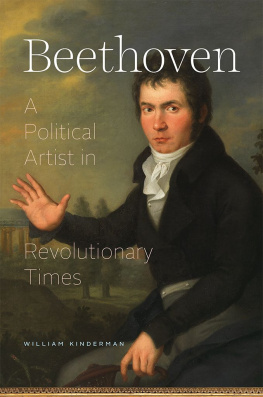
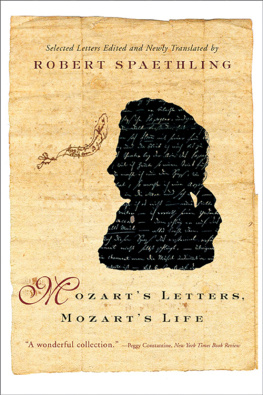
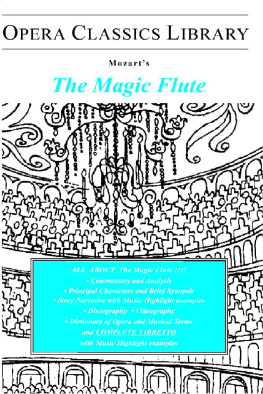
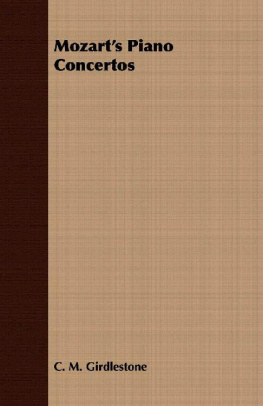
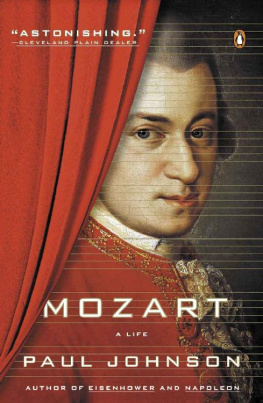
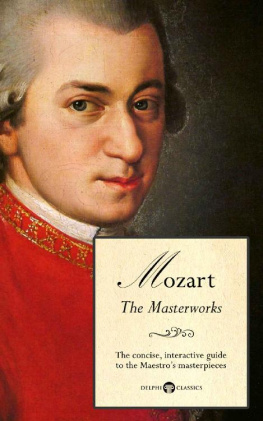
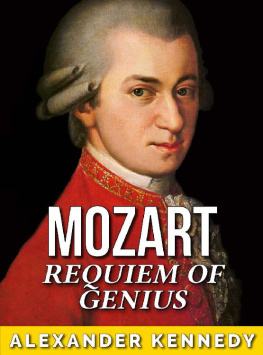
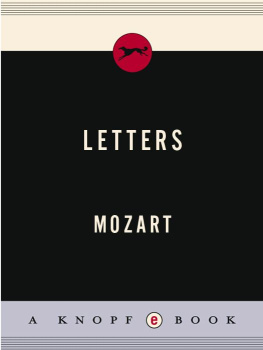
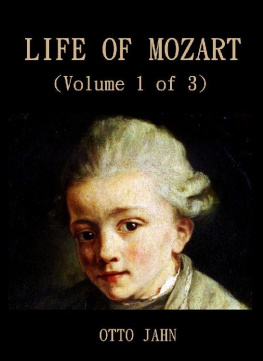
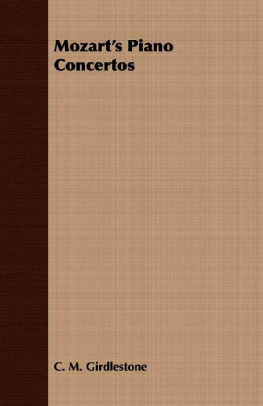


 ska, Krakw; Internationale Stiftung Mozarteum, Salzburg/Archiv and Bibliotheca Mozartiana; Staatsbibliothek preussischer Kulturbesitz zu Berlin. The Research Board of the University of Illinois generously supported my study of Mozarts manuscripts. The music examples stem largely from the Neue Mozart Ausgabe with the permission of Brenreiter Verlag; the remaining examples were prepared by Bradley Decker. Erik Horak-Hult offered valuable assistance in preparing the final typescript for publication. The following individuals made helpful comments, but are in no way responsible for remaining infelicities: Emanuel Ax, Alfred Brendel, Cliff Eisen, Robert Hatten, Robert D. Levin, Nicholas Temperley, and Mitsuko Uchida. Bruno Nettl encouraged the project by facilitating access to the Mozart collection of his late father, the distinguished Mozart scholar Paul Nettl. Material from draws on my essay Dramatic Development and Narrative Design in the First Movement of Mozarts Concerto in C Minor, K. 491 in Mozarts Piano Concertos: Text, Context, Interpretation, edited by Neal Zaslaw. My wife, Katherine Syer, supported the project in countless ways; without her vivacious energy it could not have reached publication in this anniversary year, two hundred fifty years after Mozarts birth.
ska, Krakw; Internationale Stiftung Mozarteum, Salzburg/Archiv and Bibliotheca Mozartiana; Staatsbibliothek preussischer Kulturbesitz zu Berlin. The Research Board of the University of Illinois generously supported my study of Mozarts manuscripts. The music examples stem largely from the Neue Mozart Ausgabe with the permission of Brenreiter Verlag; the remaining examples were prepared by Bradley Decker. Erik Horak-Hult offered valuable assistance in preparing the final typescript for publication. The following individuals made helpful comments, but are in no way responsible for remaining infelicities: Emanuel Ax, Alfred Brendel, Cliff Eisen, Robert Hatten, Robert D. Levin, Nicholas Temperley, and Mitsuko Uchida. Bruno Nettl encouraged the project by facilitating access to the Mozart collection of his late father, the distinguished Mozart scholar Paul Nettl. Material from draws on my essay Dramatic Development and Narrative Design in the First Movement of Mozarts Concerto in C Minor, K. 491 in Mozarts Piano Concertos: Text, Context, Interpretation, edited by Neal Zaslaw. My wife, Katherine Syer, supported the project in countless ways; without her vivacious energy it could not have reached publication in this anniversary year, two hundred fifty years after Mozarts birth.